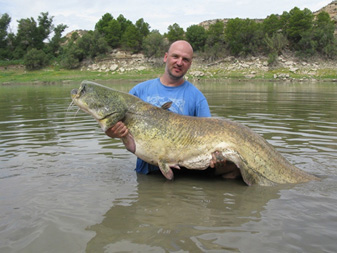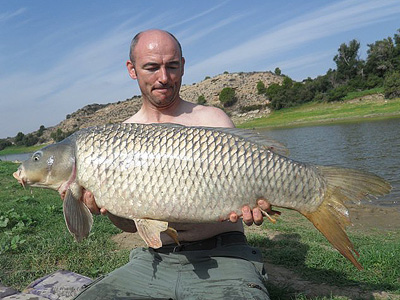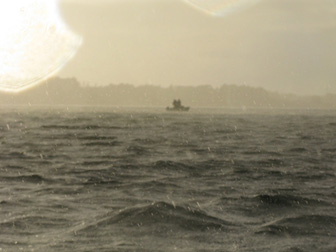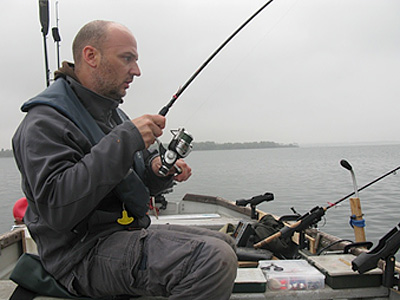Over a number of years of fishing a variety of reservoirs for their predators, deep water vertical jigging for zander has elbowed its way to become my favourite form of fishing. It is so intense and mentally engaging that my days of fishing long sessions behind buzzers and static rods are limited. Now, all summer long, I have half a mind cast to when Anglian Water will open their doors to predator fishing on their reservoirs.
 There are not many venues in the UK like Grafham Reservoir: at around 1600 acres, nearly three miles long, 1.5 miles wide and with depths to over 60 feet it is the third largest reservoir in England. There is a lot of water to go at and to get to grips with its predators properly you need to purchase some specialist tackle if you are to give yourself a realistic chance. But it is the sheer size of the venue, coupled with the proactive fishing styles and the potential for truly massive zander, that have me returning year after year.
There are not many venues in the UK like Grafham Reservoir: at around 1600 acres, nearly three miles long, 1.5 miles wide and with depths to over 60 feet it is the third largest reservoir in England. There is a lot of water to go at and to get to grips with its predators properly you need to purchase some specialist tackle if you are to give yourself a realistic chance. But it is the sheer size of the venue, coupled with the proactive fishing styles and the potential for truly massive zander, that have me returning year after year.
Over the past few years Anglian Water have permitted predator fishing to start a little earlier, in September and last year I did very well in the opening week. However this year my old school mate and fishing partner, Andy Ellis and me both turned 40 so we treated ourselves to a boy’s week away in Spain and, instead of working lures gently in the depths of Grafham, we were soaking up the sun and enjoying the best of what the River Ebro has to offer.
 We had arrived on the Ebro at the end of a very hot spell and although the fishing was slow we still enjoyed ton up cats and 40lb carp and my eyes were fully opened to the carp potential of the Ebro – I will certainly be returning.
We had arrived on the Ebro at the end of a very hot spell and although the fishing was slow we still enjoyed ton up cats and 40lb carp and my eyes were fully opened to the carp potential of the Ebro – I will certainly be returning.
Unfortunately this Spanish trip was during the last week of August and I just could not afford to be away from work after taking a week off to get out and fish Grafham. So, reluctantly, I missed the opening and settled instead for booking a day in the first week of October.
Despite the size of Grafham it is not really that daunting because when it comes down to it the venue is just like any other in that there are spots that are more productive than others. So it was that we motored to one of the deep water areas in what was a somewhat stronger than anticipated wind.
Now the wind on Grafham is the most influential of any of the elements on your day’s fishing there and it is typical of the British too little/too much syndrome. Too little wind and the fishing is likely to be hard, and you’ll cover little water on drifts. Too much wind and boat and lure control is very difficult to the point where it can render the deeper water nearly impossible to fish.
 Today I would have preferred to have knocked 5-10 mph off the wind speed!
Today I would have preferred to have knocked 5-10 mph off the wind speed!
We had been fishing in around 50 feet of water for an hour or so when the echo sounder suddenly started to play up. After around an hour of fiddling about we finally gave in and accepted that we would be fishing blind for the remainder of the day (it turns out that you can’t keep a leisure battery on trickle charge for seven years without topping it up with de-ionised water!).
Coupled with the wind that was on the strong end of acceptable, even with the use of the sounder, we decided instead to anchor up in a spot that we knew to be productive, in around 37 feet of water. Unfortunately this meant that I could no longer employ my favourite vertical jigging technique, but they say that adaption is possibly the most important tool to carry in your tackle box.
We knew the area in question always held a few fish and so the plan was to ‘jig and spin’ shads and hope that we could pick up a few zander and rescue the day. We also left out our sleeper rods which often account for a few extra fish a day and are well worth the minimal effort to put out. However, whilst accepted wisdom is to generally fish your vertically jigged lures very close to the bottom I deliberately fish the sleeper rod four or even five feet clear of the reservoir bed in the certain knowledge that I will get fewer bites…
 I do this because this rod is going to fish itself, in the rod rest. I will not be quick enough to strike any taps or knocks it gets and when vertical jigging the rod in your hand requires all of your attention. So by having the shad suspended so far off the bottom when a zander does take the lure it turns quickly for the sanctuary of the lake bed and tends to hook itself. Bites are usually un-missable with the rod tip doing its best to join the fish at the bottom of the reservoir and hooksets are usually firmly in the scissors.
I do this because this rod is going to fish itself, in the rod rest. I will not be quick enough to strike any taps or knocks it gets and when vertical jigging the rod in your hand requires all of your attention. So by having the shad suspended so far off the bottom when a zander does take the lure it turns quickly for the sanctuary of the lake bed and tends to hook itself. Bites are usually un-missable with the rod tip doing its best to join the fish at the bottom of the reservoir and hooksets are usually firmly in the scissors.
By now it was lunchtime and we had been brought back to reality from the utopian Ebro trip with a bump and we still had not had even a suspected knock for all our efforts. Casting and retrieving lures hour after hour with no reward can be hard, but you have to keep your focus as the slightest thing can change the day very quickly and on waters like Grafham it only takes one moment to latch into, or miss, something very special indeed.
You can find out just how we fared in the end in part two of ‘From the Ebro to Grafham…’ later this week!











